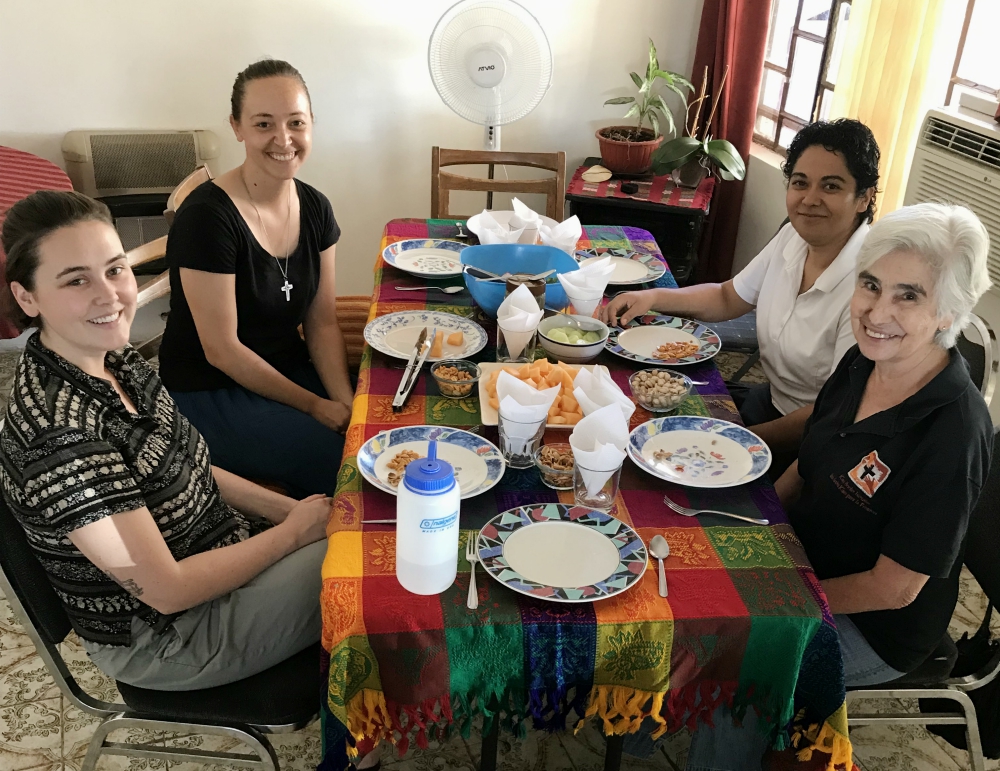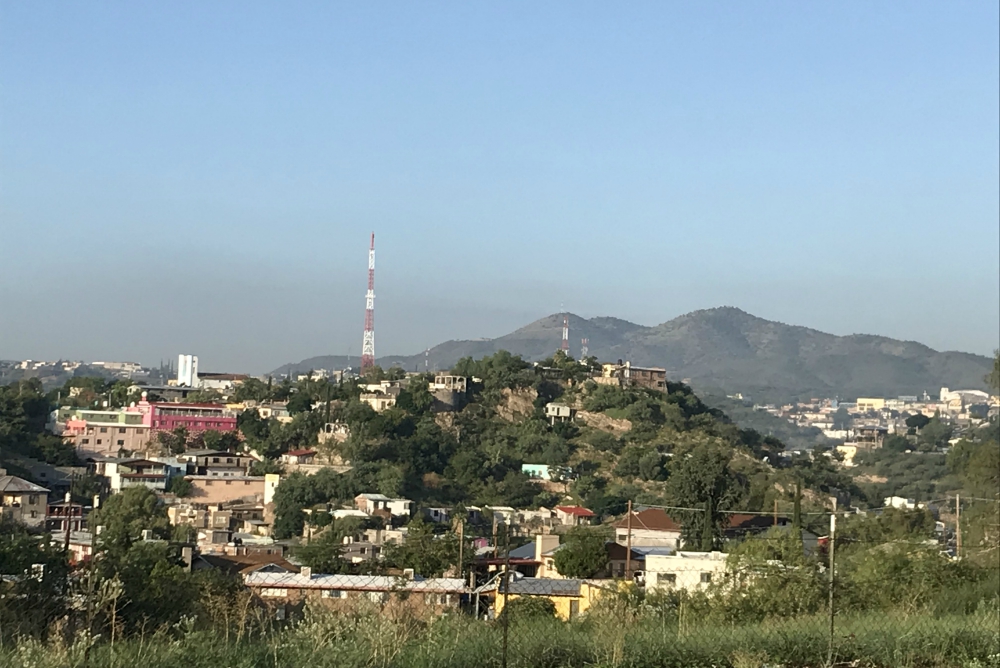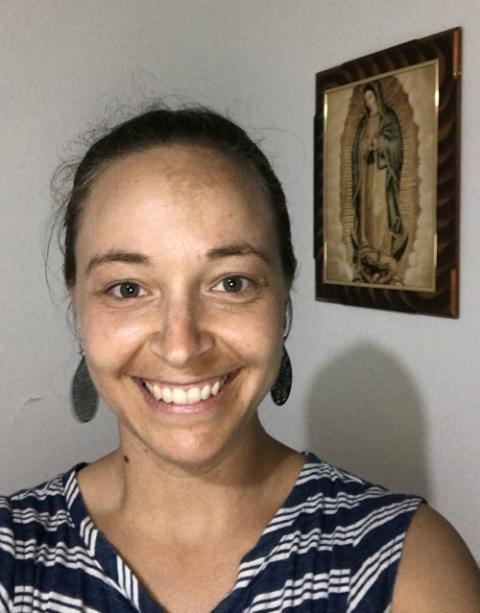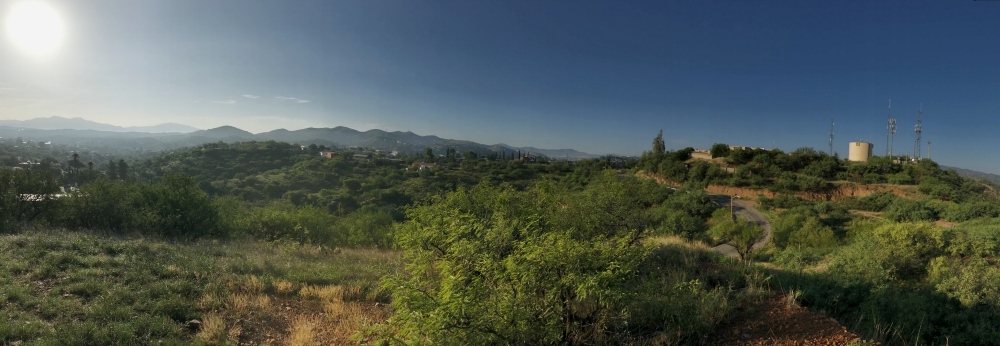
A colorful celebration at our house with Sisters Pina and Engracia and Kino Border Initiative volunteer coordinator Lizzie (Provided photo)
"Bring the tequila glasses — we're celebrating!" my housemate exclaimed. It was just another Wednesday afternoon, but with a three-course meal on the table, including fresh-squeezed juice and bread from scratch, you'd think we were commemorating something monumental, not the fact that two of us were celebrating three months since the day of our arrival.
Celebration, in these circumstances, feels both important and hard. The four of us — three Missionary Sisters of the Eucharist from Mexico and me, a Sister of Providence from the United States — share common life and a common ministry of accompanying migrants who have been deported or are seeking asylum. Their stories paint a bleak picture of a reality of violence and corruption in Mexico. Last month, 85% of those who came through the Kino Border Initiative's migrant aid center for the first time were from Mexico, and about one in six of them were fleeing violence.
This isn't shocking, given the fact that Mexico is on track to set a new record for homicides in 2019, and many migrants I meet are coming from the states where this violence has peaked: Guerrero, Chiapas, Oaxaca. The U.S. seemed to turn a horrified glance toward Mexico when a binational family from a small, tight-knit Mormon community in northern Mexico was hit by this violence earlier this month. Yet this is only part of the story.
Yes, gang violence is a devastating part of life for many people in Mexico, and its effects are profound and long-lasting. In the midst of this reality, Mexicans still treasure the richness of the place they call home. Since I moved to Nogales, Sonora, three months ago, I've met a number of families with dual U.S./Mexico citizenship or other documentation that would allow them to live in the United States but who choose to live in Mexico. They want their children to grow up in Mexican culture. As much as they might enjoy visiting the U.S. from time to time, they can't imagine being removed from their tight-knit communities. The more I integrate into the life here, the more I can appreciate why.

A view of the hills of Nogales, Mexico, from the Arizona side (Tracey Horan)
Here's some of what I've learned so far:
1. People here take celebration seriously. (See above.)
We decorate tables with bright colors and fold napkins in fancy ways. We offer multiple toasts and eat several courses of food. We take time honoring people with words, music, desserts and quality time.
2. What's mine is yours.
Not long after my move to Sonora, a sister I live with called to ask if I could bring her something she had left at home. She texted instructions about where I would find the object, starting with "My room, which is also your room ..." I was puzzled. What room would that be? Does she mean the community room? The dining room? As she went on to describe the location, I realized it was most certainly her bedroom. I started seeing this pattern of speech pop up in other circumstances: "my house, which is also your house"; "my car, which is also your car." What I hear in Mexican language, I have seen realized in the fluid nature of possession. Hospitality is part of the fabric of life here, and sharing both stuff and space seems to go along with that. I love incorporating this "what's mine is yours" language into my vocabulary and attempting to match it in practice.
Advertisement
3. We go with the flow.
As a woman with a strong German background, I can't say uncertainty is something I love. I do appreciate the ways it helps me stretch and grow. In my current reality, timing and details are fluid. Sometimes this means at 7 p.m. on a Wednesday night, we're not sure if we'll have eight or 15 guests for lunch the next day. Or it might mean that at 9:30 a.m., the food hasn't arrived to the Kino Border Initiative's migrant aid center, so the sister in charge gets everyone singing a song to distract them from the half-hour wait. I've found it also means people generally have more patience for waiting and openness to the unexpected.
4. A feminine manifestation of the presence of God looms large.

Providence Sr. Tracey Horan with the image of Our Lady of Guadalupe in her room (Tracey Horan)
You guessed it — la Virgen de Guadalupe. I love the way an indigenous, woman God-bearer adorns life in Mexico. There are at least four images of Our Lady of Guadalupe that I've found in our house so far, including the one that was waiting for me in my room when I arrived. I see her on walls, on front porches and in prominent places in churches. She encourages me and reminds me to celebrate the ways women give life to the Holy One's presence.
5. Natural beauty abounds.
To say my experience of the landscapes of Mexico is limited would be an understatement; still, descriptions of friends' hometowns further south lead me to believe the rolling green hills of Nogales are just the beginning of Mexico's natural wonders. The way towns are built into hillsides also means access to some extraordinary views. For this Hoosier from one of the flattest parts of the U.S., waking up to the foothills of the Sierra Madre Occidental still takes my breath away.
I could go on about the ways this intercultural, intercongregational life in Mexico feels like an enriching embrace. I could also go on about the challenges of widespread government corruption and machismo I witness here and feel pulled to fight against. One does not negate the other — both parts are real.
Living in the midst of this paradoxical truth often feels like an invitation to respond in the Gospel way, the nonviolent third way. For me, this third way means that in responding to the evil amid the beautiful, I am invited, in the words of theologian Walter Wink, into "a way that is neither submission nor assault, flight nor fight, a way that can secure your human dignity and begin to change the power equation."
I pray that both my celebration and hard truth-telling be inspired by this third way.

Hills of Nogales, Mexico (Tracey Horan)
[Tracey Horan is a member of the Sisters of Providence of St. Mary-of-the-Woods, Indiana. She is the education coordinator at the Kino Border Initiative in Nogales, Arizona, and Sonora, Mexico.]







